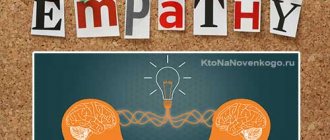“Yes, it’s the same,” we say when we understand that two objects, phenomena are no different from each other. This is identification. Identical means the same. Through factual analysis and comparison, we come to the conclusion that the two items are no different. However, in psychology this has a slightly different meaning. You and I have to understand the concepts of “identification” and “identify”: what it means, where it occurs.
What is identification: definitions
What is this? Identification is in psychology the process of an individual’s imitation of another subject, group, fictional character (image); the process of self-identification of an individual with a group, image, or another person. Identification is, in simple words, the search for an answer to the question “Am I the same as who?”
The term was introduced by S. Freud. The psychologist examined the phenomenon within the framework of psychoanalysis. The first thing Freud studied was the child’s identification with one of the parents. At the same time, the researcher came to the conclusion that identification is always based on fear and anxiety. By identifying with a stronger, more authoritative person, the individual reduces the discomfort he experiences.
However, a little later the author identified several types of identification:
- primary (child with mother);
- identification with a loved one (“I want to be like you”);
- identification with an unloved person (a defense mechanism of the psyche, “you will not offend someone like yourself”);
- identification in the perception of community (“stand in my place”, “what would he do”, “what would he think”).
Over time, the concept began to be used in a broader sense. According to him, personal identification is imitation, emotional fusion with someone. However, some psychologists still adhere to the psychoanalytic theory, arguing that it is a defense mechanism developed by evolution that helps in adaptation. Let's take a closer look at modern definitions and find out what identification means in psychology.
Identification
The meaning of the word "identification"
The name is derived from the Latin indentifico, which means “to identify.” Identification is the establishment of correspondence, similarity between two or more objects.
Identification concept
According to definitions from various dictionaries, identification is:
- identification, recognition of objects (encyclopedic dictionary);
- comparison with a standard, identification for litigation (business dictionary);
- subconscious identification of oneself with another person, often a parent (psychiatric dictionary);
- a psychological defense mechanism in which an individual becomes like his offender and identifies himself with him (psychological dictionary);
- a protective mechanism of the psyche, in which a weak person adopts the experience and features of a strong person (psychological dictionary).
In sociology, identification is understood as the process of an individual identifying himself with some group, another person. This is clearly visible in the example of youth subcultures. An individual copies the external attributes, behavior, values, beliefs, and interests of the group.
See also: PSYCHOPHISIOLOGY - directions and tasks
Levels of empathy
Several classifications of empathy can be found in the literature. The most common division is into three levels:
- High. A person has the ability to feel other people's emotions better than his own. He projects the suffering of other people onto himself, often traumatizing his own psyche. Able to understand everyone and find an individual approach. These are altruists who do not condemn anyone, know how to forgive and are afraid of offending. When a person with such a level of empathy goes into a profession related to helping people, they say about him that this (teacher, doctor) is from God.
- Average (normal). Most people have this level. They recognize well, can control and express their own emotions, and also know how to hear the interlocutor, strive to put themselves in his place and understand. Such a person can come to the rescue and provide moral support, but he has a mechanism of psychological self-defense and will not destroy his own psyche because of other people’s problems.
- Short. As a rule, it indicates underdeveloped communication skills. Such people appear cold and distant, live for themselves and do not care about what is happening in the lives of other people. They are frightened by capricious children and old people, animals that need to be looked after. They choose professions that are not associated with the team. Many people who have low levels of empathy find it difficult to form strong and long-lasting social connections. Their emotions, as a rule, are in one of two extremes: either closedness or aggression.
Find out who introverts are and how to communicate with them.
Types of identification
It can be primary and secondary. In the first case, we are talking about the child's identification with the mother, and later with the parent of the same sex as the child. In the second case, the child’s identification with other people and groups in the process of growing up is implied. It, in turn, is divided into several more subspecies. Let's take a closer look.
Situational
This is clearly noticeable in children during games, in adults - at a meeting, when meeting a new person, etc. In general, in some specific situation or conditions, an individual tries to become the same as a person significant to him.
Group
This is a stable type. It implies an individual’s commitment to the values and goals of a group. Outside of it, the subject lives by the same rules. However, sometimes group identity is situational and superficial. A person does not accept the goals and interests of the group as his own. Once he leaves this group, he will behave differently.
Cultural
This is a process of identification, adaptation to the culture of society. A person needs to find a balance between internal and external. For example, between traditions and innovation, goals and means. The subject has to realize his own potential within a particular society. Accept the norms and values of this world.
Social
This is the process of a person identifying himself as an important, active participant in society. He perceives himself as a social agent, feels that he belongs to some social group, and can pronounce “WE” with complete confidence.
Personal
This is a person’s assimilation to himself, that is, the preservation of his uniqueness. Implies unity of goals, interests, views, beliefs, motives, meanings. No matter what group a person belongs to, he always retains a set of stable characteristics.
Finding a balance between personal and public is one of the most difficult problems in psychology. Sometimes a person becomes so similar to others that he loses himself. He dissolves into other people. He forgets about his essence, loses the unity of his Self, ceases to understand himself, forgets his life story.
See also: Human individuality - what is it
Collectivist
Formed in the process of general activity. The experiences of one person are transmitted to others and become motives for common activity. Collectivist identification manifests itself in complicity and sympathy. Each team member shares the failures and successes of the other. That is, a person feels others as himself.
Sexual
The process of becoming aware of belonging to one of the genders. Interest in the body is especially noticeable in children 2–3 years old.
Gender
The process of realizing which gender (collective image of a man and a woman) a person considers himself to be. It doesn't always match the gender. Gender identity provides the answer to the question “Who do I feel like: a man or a woman?” At the same time, a person understands perfectly well which gender he belongs to. For example, a man can recognize his gender, but at the same time be vulnerable, sensitive, gentle, that is, have a set of traits that are generally characteristic of women. Likewise, a woman, despite her gender, can feel like a “man in a skirt.”
How to become yourself
In essence, identifying yourself with successful and satisfied people with life is commendable, but we must remember that everyone has their own path. The pursuit of material wealth, the daily bustle and the struggle for a place in the sun will not give you peace of mind and tranquility.
Those who have realized the value of life follow the path of spiritual search, but our “I” is terrified of waking up and seeing the world as it really is. Finding yourself can turn into an endless pursuit of a ghost that melts in the night, into the work of awakening the inner “I” without awakening this “I”.
We recommend: Social roles and statuses
Psychologists have developed several techniques that eliminate identification. One of them suggests abandoning past experiences and going beyond comfort by achieving the state of an “outsider observer.” This is a kind of meditative state achieved through measured, deep breathing and concentration of thoughts on the sensations of the body.
An identified person begins to realize his condition and builds a connection between the true “I” and the infinity of being. Gradually, consciousness is cleared of chaos and identification, enlightenment sets in, meaning the achievement of internal harmony, a feeling of oneself “here and now.”
Buddhist practices offer immersion in a state of contemplation, the meaning of which is to concentrate attention on one pre-selected subject. During meditation, a person completely merges with the observed object, disidentifying with the rest of the world around him. He loses the sense of himself as a person and gains a sense of pure being. The technique allows you to completely clear your consciousness and bring your thoughts to the simplest level.
We recommend: Identity - what is it?
Yoga uses a technique aimed at liberation from identification and achieving the state of “samadhi”. A meditating person moves away from the bustle and enters a state of nirvana - feeling being without emotional coloring beyond identification. Gradually, you begin to feel like an eternal spectator, calmly observing the world and people.
Most of the time we live automatically, according to the “home – work – home” scheme, so life sometimes throws us into shocks. The more identified a person is, the greater the shock he needs to experience in order to break away from his habitual identifications. Life forces us to move forward and work on self-awareness, spiritual growth and development. Author: Natalya Ivanova
Identification in psychology
This is the likening of an individual to some person, group, or image. Without this, the development and formation of personality is impossible. Very often identification is confused with imitation and identity. Let's look at these connections in more detail.
Identification and simulation
Imitation is conscious imitation. Identification is an unconscious process. Identification helps a person develop and build his life path. However, under unfavorable conditions, unconscious imitation leads to developmental stagnation and dissociation.
Identification and Identity: What's the Difference?
What it is? Identity is the result. Identification is a process. In the first case, a person realizes and recognizes his identity with someone. In the second case, he seeks and finds identity.
Empathy test
Tests will help you determine how empathic you are. There are many methods, below I will give two of the most popular.
Boyko Questionnaire
Here is a list of 36 questions. Opposite each is a letter. If you answer “yes”, write down the letter from the “+” column, if “no”, then write down the letter from the “-” column. If the box opposite the selected answer is empty, then we do not write anything.
What to do next? Each letter is worth one point. Count which letters you have more and which ones you have fewer. This will indicate that some channels of empathy are better developed in you, while others are worse or completely absent.
Now count how many points you have scored:
- more than 30 points – high level of empathy;
- 22–29 points – average level;
- 15–21 points – reduced;
- less than 14 points – very low.
Mehrabian Questionnaire
The task is the same, only here you don’t need to define the letters. It is enough to count the number of points scored.
The author divided the results depending on the gender of the person being tested.
| Women | Men | |
| High | 33–30 | 33–26 |
| Average | 29–23 | 25–17 |
| Short | 22–17 | 16–8 |
| Very low | 16 or less | 7 or less |
I recommend reading the publication on how to understand yourself.
What does identification mean in forensics?
This is a determination of the identity of a person based on general and specific characteristics, for example, fingerprints and handwriting. In addition to identifying individuals, criminologists are engaged in identifying objects:
- seals based on impressions;
- weapons by bullets, cartridges;
- shoes on the tracks;
- tools for burglary or other crime in the wake of burglary or other crime;
- car following wheel tracks;
- other.
The whole is also identified by its individual parts.
See also: CONFORMISM - what is it in simple words
Identification methods
To determine identity, criminologists use static and dynamic methods. The first includes the analysis of the biological and physiological characteristics of the individual:
- palm print, fingerprint;
- shape, features, proportions of the face;
- drawing of the retina, iris;
- height, body proportions, size of arms, legs;
- handwriting, signature.
Most often, dactyloscopy (fingerprint analysis) and identification of a person by appearance are used:
- thickness, length, other features of the limbs;
- back features;
- breast specificity;
- characteristics of shoulders, neck;
- wrinkles;
- shape of the auricle;
- teeth;
- height;
- weight;
- lips;
- nose;
- eyes;
- brows;
- forehead;
- face;
- hair;
- floor;
- age;
- general body type;
- head.
Dynamic methods include the analysis of everything related to behavior:
- speech,
- facial expressions,
- gestures,
- poses,
- gait,
- voice,
- posture.
Advantages and disadvantages
Above, we discussed three levels of empathy. At first glance, it may seem that the higher the level of empathy, the better. But this is not true in all cases.
What are the benefits of empathy?
- has a beneficial effect on any type of relationship with people - friendly, love, business;
- expands the perception of the world;
- promotes peaceful resolution of conflicts;
- prevents aggression;
- helps fight ideological prejudices such as racism, sexism, xenophobia, etc.;
- develops altruism;
- promotes more effective implementation in a profession related to helping people (doctors, educators, teachers, psychologists, rescuers, nannies, nurses).
Now about the disadvantages of a high level of empathy:
- such people often become victims of scammers, manipulators, parasitic relatives and friends;
- unstable, changeable mood;
- precarious mental balance that can be shaken by any negative news;
- emotional recovery can take a long time;
- strong empaths have a constant feeling of guilt for actions and events to which they have nothing to do;
- can lead to self-sacrifice, when helping others comes at the expense of one’s own needs and interests;
- often give the impression of weak-willed individuals, unable to fight back boors and rude people.










